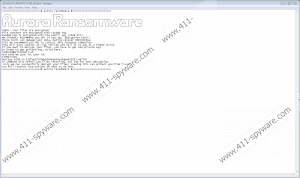Aurora Ransomware Removal Guide
We are sure you do not want any kind of malware invading your Windows operating system, but Aurora Ransomware is the kind of threat that you REALLY do not want to face. If it finds its way in, it can quickly and silently encrypt all of your personal files and then terrorize you with ridiculous ransom demands. The creator of the infection wants you to believe that your files could be decrypted if you paid a ransom for the so-called private key. First of all, we cannot guarantee that cyber crooks would send you the key. Second, we cannot guarantee that what you would receive would be a key and not another malicious infection. The truth is that most ransomware victims do not get to decrypt their files, which means that they end up losing files and money. Other infections that pose the same kinds of threats to personal files and the users’ financial wellbeing include Crybrazil Ransomware, Scarab-Osk Ransomware, and Rebus Ransomware. The removal of these threats has already been discussed previously. In this report, we explain how to delete Aurora Ransomware.
Malicious installers, unsecure RDP connection channels, spam emails, and active infections can be used to drop ransomware. This is how the devious Aurora Ransomware could have landed onto your operating system as well. In all cases, it must slither in silently because if the victim discovers the threat right away, they might remove it before the encryption of personal files is initiated. The infection is very quick when it comes to encryption, and as soon as the encryption key is obtained – it should be downloaded from a remote server – it is immediately employed to corrupt data. Once the files are damaged, the “.Aurora” extension is appended to the names, and that can make it easier for you to check out the situation. Hopefully, after checking the files, you can determine that backup copies exist online or on external storage devices, in which case, you do not need to worry about the files, and all you must do is remove Aurora Ransomware. Of course, you need to get rid of this infection even if the only copies of your personal files were corrupted because the longer this malware stays on your operating system, the longer you will stay at risk.
Besides the original launcher (.exe file with a random name), Aurora Ransomware only creates ransom note files. The sample that we tested in our internal lab created 6 different files. The original name of this file is “HOW_TO_DECRYPT_YOUR_FILES.txt,” and the copies have numbers 2-6 attached at the end. Every single one of these files carries the same message, and the point of it is that you need to send $100 worth of Bitcoin to the 172fqoLfYkMQXk6tmEqGH3y43gQwAzSSFJ wallet. This Bitcoin wallet does not have any transactions at the moment, and, hopefully, it will stay empty in the future as well. Even if you pay the ransom as told, and then email cyber criminals behind Aurora Ransomware at lenboza@protonmail.ch, you are unlikely to get anything in return. Sure, the ransom note suggests that you can get a “private key” that you allegedly need for decryption by following all of the steps, but you need to be smart about all of this. Cyber criminals are NOT worth your trust, and you cannot trust their word in a situation like this. The bottom line is that you will not be able to force the criminals to give you what was promised when you complete the transaction.
Where is the launcher of Aurora Ransomware? What is its name? These are the questions we cannot answer for you, and that is why you might have a harder time eliminating this ransomware manually. Of course, no one says you HAVE to delete the infection manually. Why not install an automated anti-malware tool that would remove Aurora Ransomware for you? According to our research team, this is the best option because this software is primarily designed to keep malicious infections away, and you need reliable protection. Another thing you need is a reliable file backup. Whether you use cloud storage (online) or external drives, you MUST back up personal files because that is the only sure way to keep them safe. Note that ransomware is not the only kind of malware that can affect files. Also, from time to time, we always encounter malware that is capable of circumventing anti-malware software. Keep this in mind the next time you open a spam email.
How to delete Aurora Ransomware
- Find and Delete the {random name}.exe ransomware launcher.
- Go to the Desktop and Delete all versions of the HOW_TO_DECRYPT_YOUR_FILES.txt file.
- Install a trusted malware scanner and perform a full system scan.
- If leftovers are detected, delete them as soon as possible.
Aurora Ransomware Screenshots:


